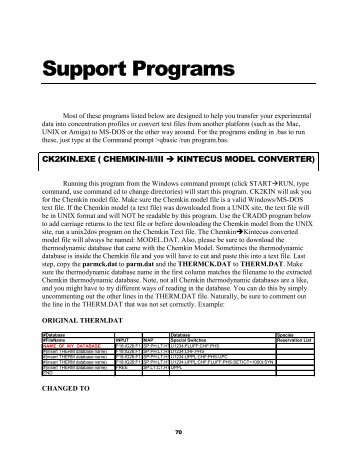
N heptane detailed mechanism version 3 This mechanism represents an updated release of the previous version available on the website (Version 3.0). The mechanism is based on the previously developed and very successful mechanism of Curran et al. CHEMKIN-PRO (x64). The most popular version of this product among our users is 4.5. The most popular version of this product among our users is 4.5. The product will soon be reviewed by our informers.
ANSYS Chemkin-Pro Understanding and predicting the effects of chemistry in a system are key to developing competitive products in transportation, energy and materials processing applications. As designers of gas turbines, boilers and piston engines strive to meet low-emissions regulations with ever widening fuel flexibility requirements, they must also maintain, or even improve, their system's performance. Similarly, designing high-throughput materials and chemical processes with high yield and quality must be done with minimal byproduct or waste. Relying on testing alone for accurate performance validation is prohibitive, given today's complex designs and shortened design cycles. Effective simulation of the underlying detailed chemistry is often critical for cost-effective design of systems with reduced pollutant emissions or undesired byproducts. See a whole new view To help you gain key insights into kinetics dependencies, Chemkin-Pro includes the Reaction Path Analyzer.
Employing an interactive visual display, the Reaction Path Analyzer provides a clear view of dominant reaction paths, facilitating mechanism development and reduction. Use reactor networks to model complex flow-fields Equivalent Reactor Networks (ERNs) allow simulation of real world combustors, burners and chemical reactors, enabling the most efficient prediction of emissions with detailed chemistry.
Gain better understanding of low emissions combustion stability The Chemkin-Pro Extinction Model accomplishes fast, accurate calculations of the extinction strain rate used to determine a system's combustion stability. This is important in premixed low-NOx combustion systems.
Understand and predict particle formation The innovative Particle Tracking feature of Chemkin-Pro follows particle nucleation, growth, aggregation and oxidation. Two separate tracking approaches enable you to predict the average particle size and number density, and/or detailed information on the particle size distribution, which can be used to predict soot emissions or to optimize particle production. Easily create CFD flamelet tables with speed and accuracy Many combustion system developers use combustion models that depend on flamelet table lookups in their CFD simulations. Chemkin-Pro provides a robust and fast method to create these flamelet tables for input into CFD models. Explore how input uncertainties affect simulation results Enhance the robustness of your simulation results with the ability to calculate error bars based on user-defined input accuracy ranges.
Plug-in compatibility with Gamma Technologies GT-Suite 2016 ANSYS Chemkin-Pro enables you to better evaluate and optimize powertrains for fuel effects, efficiency, knocking and emissions. GT-SUITE gives you access to detailed and validated reaction mechanisms in the ANSYS Model Fuel Library as an alternative to the standard GT-SUITE models.
• A Path Flux Analysis Method for the Reduction of Detailed Chemical Kinetic Mechanisms Wenting Sun, Xiaolong Gou, Zheng Chen, Yiguang Ju. Combustion and Flame, Vol. 157(7), 2010, pp. 1298-1307 • A Dynamic Multi-Timescale Method for Combustion Modeling with Detailed and Reduced Chemical Kinetic Mechanisms Xiaolong Gou, Wenting Sun, Zheng Chen, Yiguang Ju Combustion and Flame, Vol. Altium library torrent.
157(6), 2010, pp. 1111-1121 • PRINCETON CHEM-RC (2.0): A software to generate skeletal/reduced chemical kinetic mechanisms by using Multi-generation Path Flux Analysis (PFA). Updated: October 9 th, 2016 (with mechanism interpreter; documentation included).
PLOG software for Chemkin II and III Updated: June 28th, 2011.